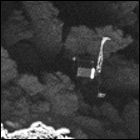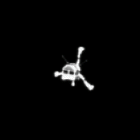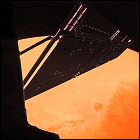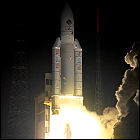Finding Philae
 With mere weeks left before the European Space Agency’s Rosetta space probe is shut down, the spacecraft’s gradually decreasing orbit allows it to see more fine detail on the surface of Comet 67P/Churyumov–Gerasimenko, which is now outbound near the orbit of Jupiter. Rosetta’s surface survey finally reveals the fate of the short-lived Philae lander: as ESA engineers suspected in 2014, it came to rest on its side in a crevasse, preventing its batteries from recharging via its solar panels. Originally aimed at the Agilkia region on the larger of Comet 67P’s two “lobes”, Philae’s harpoon anchoring system failed to fire, leaving the lander to bounce helplessly into a ravine on the smaller lobe of the comet, in the Abydos region. It only relayed its surface findings to Rosetta for three days in late 2014. Rosetta would soon join Philae on the surface, with a surface impact scheduled for September 30, 2016.
With mere weeks left before the European Space Agency’s Rosetta space probe is shut down, the spacecraft’s gradually decreasing orbit allows it to see more fine detail on the surface of Comet 67P/Churyumov–Gerasimenko, which is now outbound near the orbit of Jupiter. Rosetta’s surface survey finally reveals the fate of the short-lived Philae lander: as ESA engineers suspected in 2014, it came to rest on its side in a crevasse, preventing its batteries from recharging via its solar panels. Originally aimed at the Agilkia region on the larger of Comet 67P’s two “lobes”, Philae’s harpoon anchoring system failed to fire, leaving the lander to bounce helplessly into a ravine on the smaller lobe of the comet, in the Abydos region. It only relayed its surface findings to Rosetta for three days in late 2014. Rosetta would soon join Philae on the surface, with a surface impact scheduled for September 30, 2016.
Dr. Claudia Alexander, Galileo project manager, dies
 Dr. Claudia Alexander dies at the age of 56, while still serving as the chief scientist of a suite of U.S.-provided instruments aboard ESA’s history-making Rosetta mission. Renowned as one of JPL’s finest research scientists, she was a member of the Galileo plasma instrument science team before becoming, by the mission’s end in 2003, the project manager of that mission to Jupiter.
Dr. Claudia Alexander dies at the age of 56, while still serving as the chief scientist of a suite of U.S.-provided instruments aboard ESA’s history-making Rosetta mission. Renowned as one of JPL’s finest research scientists, she was a member of the Galileo plasma instrument science team before becoming, by the mission’s end in 2003, the project manager of that mission to Jupiter.
Ambition soundtrack
 IDMusic releases Ambition by Atanas Valkov, and album that serves, in part, as the soundtrack to the short film accompanying the European Space Agency’s Rosetta mission to Comet 67P/Churyumov–Gerasimenko.
IDMusic releases Ambition by Atanas Valkov, and album that serves, in part, as the soundtrack to the short film accompanying the European Space Agency’s Rosetta mission to Comet 67P/Churyumov–Gerasimenko.
Philae: first soft landing on a comet
 Launched in 2004, the European Space Agency’s Rosetta space probe, orbiting Comet 67P/Churyumov-Gerasimenko in the outer solar system, releases the Philae robotic lander to descend to 67P’s surface. The lander’s harpoon anchoring system doesn’t work entirely as expected, and Philae bounces off the surface and goes spaceborne again for two hours before coming to rest on the comet once more. Though Philae is able to gather scientific data and the first-ever pictures from a comet’s surface, the nearby geography prevents its solar panels from keeping its batteries at a full charge; ESA ground controllers are only able to intermittently contact Philae.
Launched in 2004, the European Space Agency’s Rosetta space probe, orbiting Comet 67P/Churyumov-Gerasimenko in the outer solar system, releases the Philae robotic lander to descend to 67P’s surface. The lander’s harpoon anchoring system doesn’t work entirely as expected, and Philae bounces off the surface and goes spaceborne again for two hours before coming to rest on the comet once more. Though Philae is able to gather scientific data and the first-ever pictures from a comet’s surface, the nearby geography prevents its solar panels from keeping its batteries at a full charge; ESA ground controllers are only able to intermittently contact Philae.
Rosetta at Mars
 ESA’s unmanned Rosetta space probe, carrying the Philae lander bound for a 2014 rendezvous with Comet 67/P Churyumov–Gerasimenko, makes a gravity-assist flyby of planet Mars to alter its trajectory. As Rosetta will be only 160 miles from the Martian surface at its closest approach, the spacecraft is put into a safe mode for this critical part of its trip, and emerges unscathed. Its next gravity assist will come from Earth itself later in the year.
ESA’s unmanned Rosetta space probe, carrying the Philae lander bound for a 2014 rendezvous with Comet 67/P Churyumov–Gerasimenko, makes a gravity-assist flyby of planet Mars to alter its trajectory. As Rosetta will be only 160 miles from the Martian surface at its closest approach, the spacecraft is put into a safe mode for this critical part of its trip, and emerges unscathed. Its next gravity assist will come from Earth itself later in the year.
Rosetta lifts off
 After years of delays that forced a rewrite of the entire mission plan, the European Space Agency launches the Rosetta unmanned space probe on a looping, ten-year journey through the solar system that will hopefully take it to a rendezvous with Comet 67/P Churyumov–Gerasimenko in ten years. The mission plan calls for Rosetta to orbit the comet and release a small lander, Philae, to descend to its surface. In the intervening years, Rosetta will also have opportunities to study Mars and various asteroids as it passes by them. Rosetta’s mission profile is similar to that of NASA’s cancelled 1990s CRAF (Comet Rendezvous / Asteroid Flyby) mission.
After years of delays that forced a rewrite of the entire mission plan, the European Space Agency launches the Rosetta unmanned space probe on a looping, ten-year journey through the solar system that will hopefully take it to a rendezvous with Comet 67/P Churyumov–Gerasimenko in ten years. The mission plan calls for Rosetta to orbit the comet and release a small lander, Philae, to descend to its surface. In the intervening years, Rosetta will also have opportunities to study Mars and various asteroids as it passes by them. Rosetta’s mission profile is similar to that of NASA’s cancelled 1990s CRAF (Comet Rendezvous / Asteroid Flyby) mission.